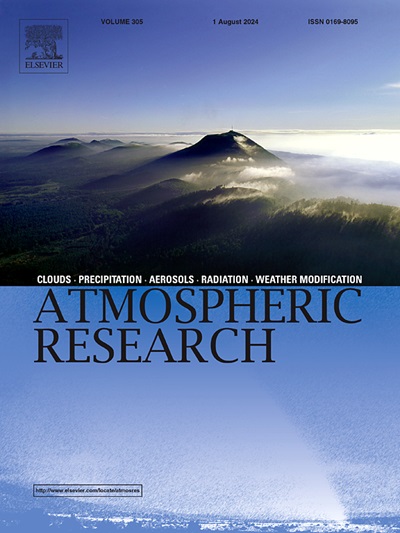Radar characteristics of seeded and unseeded hail clouds in Romania
IF 4.5
2区 地球科学
Q1 METEOROLOGY & ATMOSPHERIC SCIENCES
引用次数: 0
Abstract
This study evaluates the effectiveness of silver iodide (AgI) cloud seeding in Romania by comparing radar-derived parameters of 20 seeded and 20 unseeded severe hailstorms observed between 2017 and 2022. Radar data from S and C-band systems were analyzed using six key parameters, including maximum reflectivity (Zmax), vertically integrated liquid (VIL), Volume of the cloud with reflectivity more than 35 dBZ (dV35) and height of the 45dBZ echo above the environmental melting level (dH45). Statistical comparisons were conducted using the Mann-Whitney U test to identify significant differences between the two storm groups. The results reveal statistically significant differences in radar metrics between seeded and unseeded storms, with seeded storms generally exhibiting lower parameter values. For instance, median Zmax was 58 dBZ for seeded storms compared to 60 dBZ for unseeded storms, while VIL medians were 19 kg/m2 and 27 kg/m2, respectively. Similarly, dV35 was reduced by approximately 22 % in seeded storms. These differences indicate that seeding modifies storm microphysical processes and dynamics, potentially suppressing hail formation. However, variability across storm environments and radar categories highlights some uncertainties. Natural fluctuations in convective processes and challenges in tracking seeding agent dispersion complicate the interpretation of results. Nonetheless, the statistical significance of observed differences supports the hypothesis that AgI seeding influences storm characteristics. This study provides quantitative and statistical evidence of seeding effect and underscores the need for further research using advanced radar technologies and larger datasets to refine hail suppression methodologies.

求助全文
约1分钟内获得全文
求助全文
来源期刊

Atmospheric Research
地学-气象与大气科学
CiteScore
9.40
自引率
10.90%
发文量
460
审稿时长
47 days
期刊介绍:
The journal publishes scientific papers (research papers, review articles, letters and notes) dealing with the part of the atmosphere where meteorological events occur. Attention is given to all processes extending from the earth surface to the tropopause, but special emphasis continues to be devoted to the physics of clouds, mesoscale meteorology and air pollution, i.e. atmospheric aerosols; microphysical processes; cloud dynamics and thermodynamics; numerical simulation, climatology, climate change and weather modification.
 求助内容:
求助内容: 应助结果提醒方式:
应助结果提醒方式:


